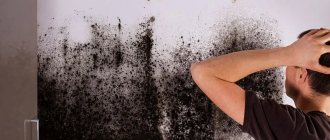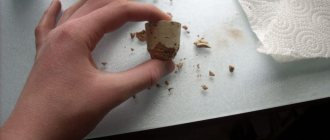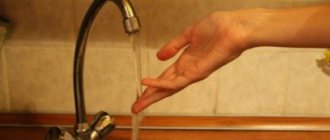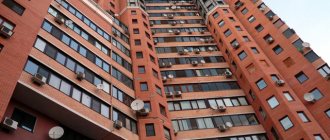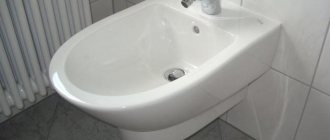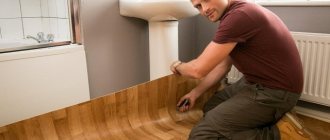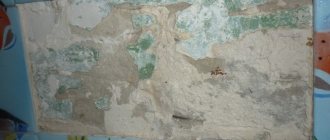Condensate is a product that is formed when water changes from gaseous to liquid form. The amount of moisture in the air is determined by the temperature of the room. The warmer the air temperature, the greater the amount of water vapor it can hold. When temperatures drop to a certain level, moisture from the air turns into a liquid state, dew or condensation occurs.
There is a temperature value that is called the “dew point”. This is an indicator of the maximum saturation of air with moisture at a constant temperature. When warm air comes into contact with a cool surface, a physical phenomenon occurs - condensation.
Condensation occurs in all rooms with high relative humidity. In apartments, bathrooms, toilets, kitchens, basements with heating pipes, and balconies suffer from this phenomenon. Dew falls on the tiles, water and sewer pipes, the cistern, and condensation appears on the windows. This harms functional structures; humidity has a destructive effect on metal products and connecting elements.
Fighting dampness
To reduce the formation of water vapor with its subsequent condensation into water droplets, it is necessary to organize good ventilation of the internal space. Modern technological solutions make it possible to create high tightness of windows and doorways, and organize high-level thermal insulation. For a healthy microclimate in residential and non-residential premises, it is important to take care of air conditioning and ventilation.
Each room has a system of organized natural ventilation, which is implemented through channels and air ducts installed during the construction of the premises. Additionally, thanks to the installed fans, air flows are forced upward, removed from the apartment and air masses circulate.
Natural ventilation does not cope well with high humidity in bathrooms and kitchens. Loggias, rooms without windows, and basement rooms need additional ventilation.
We recommend the product Exhaust fan Helios MiniVent M1/100 5 reviews
In stock
Finish: matte | Fan noise level, dB: 25, 30 | Air consumption, m³/hour: 75, 90 | Diameter, mm: 100 |
Traditional methods
In some cases, the use of special products is not possible, as they can damage the finishing material. It is worth considering that folk remedies only help when minor black spots appear. Effective folk methods include:
- Creosote, which is produced by using tar. This substance has been used for many decades to treat wooden sleepers, which ensures their service in the open air for a long period. Creosote is diluted using ethers or alcohol-containing substances. Creosote contains substances that can be harmful to human health. Therefore, after using the substance, it is recommended to rinse it thoroughly.
- Ordinary vinegar can also partially solve the problem of removing fungal growths. Natural products are used in its production, which ensures that the substance is environmentally friendly. The only drawback of vinegar is its unpleasant smell. Vinegar can be applied to the surface using a regular sprayer. After spraying it, it is recommended to mechanically treat the surface and rinse everything off with water.
You can clean the surface by using other substances that may be found in the kitchen. Examples include baking soda, alcohol, essential oils, chlorine, laundry bleach, and so on.
In conclusion, we note that folk remedies are used only if other methods of combating fungal formations are taken. Otherwise, some time after surface treatment, black mold may appear in another place.
How to reduce humidity in the bathroom
The bathroom is considered the wettest room in a living space. Lack of solar heat, poor ventilation, and high water content in the air create a favorable environment for the development of bacteria, fungus, and mold. Once such harmful formations are allowed to appear, it will be very difficult to get rid of them.
Humidity is reduced by comprehensive solutions: installing forced ventilation and thermal insulation of pipes, walls, and floors. It is recommended not to allow relative humidity levels to rise above 70%. Supply and exhaust ventilation should be installed not only in the bathroom or shower room, but also in the bathroom and kitchen.
The operation of an exhaust fan will not have any effect if there is no influx of fresh air. The air that is drawn out of the room must be compensated by fresh air flow. This is the only way the moisture will leave and condensation will not form on the tiles in the bathroom.
We recommend the product
Exhaust fan Soler&Palau Silent-100 CZ Design (5210601800) 7 reviews
In stock
Finish: glossy | Fan noise level, dB: 26.50 | Air consumption, m³/hour: 85 | Diameter, mm: 100 |
Why is black mold dangerous?
Microorganisms can only interact with natural materials, for example, wood. Therefore, ceramic tiles retain their basic performance qualities throughout their entire service life. Of course, the black spots that run along the seams and surface of the finishing material cannot be called attractive.
But it’s worth fighting black mold not only because it spoils the appearance of the bathroom. Microorganisms can enter the human body and have negative effects on health. Experts say that it is most dangerous for older people and children who suffer from various diseases. During its long lifespan, black mold releases spores that enter the human body through airborne droplets and cause the following diseases:
- Eczema.
- Bronchial asthma.
- Joint disease.
- Chronical bronchitis.
- Allergies.
- Dermatitis.
- Oncological diseases.
It is worth considering that allergy sufferers may experience a reaction even after short-term contact with spores and the mold itself. In addition, even careful attempts to destroy it with the help of special substances do not give lasting results. Experts recommend approaching the issue comprehensively, since by making the environment less favorable for the development of mold, you can effectively get rid of it.
How to organize forced ventilation
The most inexpensive way to improve bathroom ventilation is with exhaust fans. They can be easily installed in the provided holes in the ventilation duct. Before installation, check the cleanliness of the shaft. You should also pay attention to the presence of a gap under the door through which air will be replenished.
Some models of such fans have a hygrostat or motion sensors. This is very convenient: the device will turn on when the humidity in the room increases or when it detects the presence of a person in the room. Exhaust fans may not provide high efficiency, but the humidity concentration will decrease.
The supply valve will provide greater efficiency. This is a special small device that creates an influx of fresh air from the street. Structurally, it is a pipe with heat and sound insulation and an internal damper. Such organization of passive ventilation is not possible in all rooms; it is usually installed during the construction of houses. It effectively solves the problem of ventilation of rooms without windows.
The most correct option for solving the problem of condensation on the walls, ceiling or tiles in the bathroom is to install an air handling unit. This is equipment that will provide an influx of fresh air and an outflow of exhaust air into all rooms.
Antiseptics
The ability to resist fungi and bacteria is another useful property, in addition to moisture resistance, that materials and objects for the bathroom should have: for example, stainless steel and plastic are unattractive to infection on their own. Many paints and tile grouts have antiseptic properties - choose them. Areas of the floor, ceiling and walls that are especially susceptible to infection, as well as the inside of the shower stall, can be treated with a special antiseptic composition.
Operating principle of the air handling unit
Exhaust ventilation allows you to control the humidity of the room, create the most comfortable microclimate in the room and ensure continuous circulation of air flow.
Air handling units (AHUs) are used to ventilate huge halls, shopping and entertainment centers, social facilities, and industrial premises. There are compact installations designed for apartments and rooms.
We recommend the product
Air handling unit Vents VUT 180 P5B EC A21
In stock
Minimum temperature of transported air, °C: -25 | Depth, mm: 600 | Height, mm: 302 | Width, mm: 900 | Maximum pressure, Pa: 280 | Noise level, dB: 33 | Air consumption, m³/hour: 220 |
Why does this happen?
An apartment or private house often suffers from two or even more reasons. And increased humidity on the walls can appear at different times of the year. For example, in winter it is typical:
And at other times of the year, high humidity inside and outside the home is most common.
Now in more detail. Why does the problem of damp walls in the house arise?
External moisture
This problem is typical for apartments located on upper floors with a poor drainage system.
Water can enter the walls through microcracks or poorly sealed seams. The wall can also become damp due to a drainpipe passing nearby.
Panel houses often get wet, unlike others, and all because of the seams between the plates. During the construction of the building, construction technologies could have been violated, which led to depressurization.
To get rid of this problem, you will have to clean the walls from the damp coating, plaster them, prime them, and cover them with waterproofing mastic.
Such actions can be done independently either in a private house or in an apartment on the ground floor. In other cases, you will have to seek help from specialists.
Watch the video: why walls in a new building get wet and how to avoid it.
Excessive humidity
If we are talking about a brick building, then a large amount of moisture is formed due to the basement. In other cases, replacing windows in the apartment can contribute to the appearance of pockets of dampness. This is explained by the fact that the installed plastic windows are very sealed and close the openings too tightly, so ventilation in the rooms deteriorates.
As a result, condensation appears and the windows sweat. Sometimes it is enough to ventilate the room to avoid this problem. If it is not resolved, then you can try to improve the operation of the ventilation system.
Also, the old brick buildings themselves are full of cracks and small chips, thereby making a good path without obstacles to moisture from the street.
Mold
Mold is a fungus that, if prolonged, can lead to deterioration in the health of residents.
It appears on damp, damp and cold walls. It follows that if there are problems with heating, ventilation and thermal insulation, the chance of mold occurring is very high. A combination of all reasons increases the likelihood of mold occurrence.
For example, if the apartment has poor ventilation and winter has arrived. Poor ventilation of rooms increases humidity, and frost from the street freezes the walls, thereby creating favorable conditions for mold. Poor heating coupled with these problems can make things even worse. When mold appears, it must be dealt with immediately.
To get rid of this problem, you need to treat the affected areas with an antifungal agent, dry it and re-cover it with plaster.
Poor air ventilation
To avoid high humidity in the apartment, it is important that the ventilation system works properly . You can check the quality of its work using a piece of paper by placing it on the grate. If it holds and does not fall off, then there is traction and the channels are not clogged.
If there is no draft, you will need to install additional devices designed to establish air circulation. When there is no debris in the hole, but the draft is weak, additional slits are made at the bottom of the door so that air flows better. If these measures do not help, then specialists install a forced exhaust in the ventilation duct.
Wall freezing
This phenomenon occurs when the temperature outside is too low and the air inside the room is not warm enough. Because of this, the walls begin to freeze, and moisture appears on its inner surface.
Poor ventilation accelerates getting wet as it leads to high humidity. And moisture will readily condense on the ice wall.
The wall can also freeze due to the presence of microcracks or leaky joints. To eliminate this problem, sometimes it is enough to increase the room temperature, but the most effective way would be additional external insulation of the walls.
Recent renovation
The problem of wet walls occurs due to renovations done not so long ago. It occurs when plaster mixtures and putties were used during finishing. Such materials contain a large amount of water, which is absorbed by the base of the wall.
It is important to understand that a damp and cold wall will continue to accumulate moisture. Therefore, it is better not to do wet repairs (plaster, putty) in frosty weather. Or use heat guns to dry the walls.
This is considered the norm, but it is necessary to ventilate such rooms, since moisture remains inside the walls for some time. This usually goes away on its own within a week.
Additional reasons
Additional reasons include insufficient heating of the room, too thin walls, formation of voids in floor slabs, etc.
Often, dampness in a home is caused by improper foundation insulation . If its waterproofing is insufficient, then if groundwater rises by more than 1.5 meters, it can penetrate the walls. In this case, the manifestation of excess moisture will be observed under the baseboards, the plaster will begin to fall off, and the wallpaper will peel off.
Sometimes you can see how only the upper corners become damp. This problem occurs more often in the cold season. In private houses or apartments on the top floors, dampness occurs due to the attic. This happens when:
Siphon cleaning
The siphon under the sink, bathtub or shower is a good place for bacteria to grow.
Hair, particles of cosmetics, and fat settle in it, and then cool and literally stick to the walls. This is an excellent environment for the growth of bacteria, and gradually the mass of sewage only becomes larger, causing not only an unpleasant odor, but also complicating the outflow of wastewater. If the cause of the unpleasant odor lies precisely in the siphon, then the procedure will be as follows:
- remove the siphon and clean it of adhering deposits. It is appropriate to place a basin or bucket under the siphon so as not to stain anything;
- wash the siphon walls with dishwashing detergent;
- install a clean siphon in place, ensuring the tightness of all joints;
- Use drain cleaners regularly to prevent sediment from accumulating there.
The siphon (hydraulic seal) takes on an important function in terms of protection against odors. Thanks to the existence of a water plug, stench simply cannot get into the apartment. Siphons come in bottle, tubular and corrugated types. The bottle type is ideal for the sink; it is easy to install. The cheapest option is a corrugated siphon.
Why does it appear?
Before you begin to expel mold or mildew from the bathroom, you should identify the causes of its occurrence. Most often, black-gray plaque appears under the following conditions:
- poor ventilation;
- lack of natural light;
- condensation, which often forms on cast iron pipes and cold walls;
- increased humidity due to leaking taps;
- Insufficient heating of the heated towel rail.
Mold at the junction of the wall and the bathtub For mold to appear, just a couple of the listed factors are enough. To prevent unpleasant manifestations, you must do the following:
- equip the hood with a fan that can start when the lights are turned on;
- replace cast iron pipes with plastic ones, and also, if necessary, insulate the walls;
- If there is low heat transfer from the heated towel rail, then an additional heater should be installed.
What to do
If such a situation arose after renovation, then it is enough to ventilate the rooms more often. If this is a cold period of time, then it is important that the room is warm enough.
If the batteries are not enough, you can use additional heaters. When the problem lies in ventilation, you can try to remove foreign objects that interfere with normal air circulation.
Insufficient waterproofing is a more complex problem. It is important to find the place where the water comes from and isolate it well. The main source is seams on the outside of the house. This task should only be solved by specialists.
Useful video webinar about wet walls and insulation. How does this happen and how to solve it.
Get rid of moisture outside
You can and should immediately begin to solve the problem if you know the reasons. Ventilating and heating is not the best idea, as it partially eliminates dampness. It's best to do something like:
It is worth considering that sealing seams in one part of the apartment will only get rid of the problem for a while. For high-quality and long-term service of the building in proper condition, it is necessary to make repairs throughout the entire house.
Strengthen and correct ventilation
If the ventilation in the house is poor and the walls are wet, then you need to restore the ventilation. At the local level, this is very simple to do - you need to move the cabinet or other furniture. To clean the ventilation itself, you will need to remove the blockage in it. This can be done manually and using a vacuum cleaner.
For proper and high-quality ventilation in a private home, you need the help of specialists.
Disruption of air flow is caused by a violation of the layout or its change on the upper floors in a brick or panel house.
If the traction is still weak, you can strengthen it further. To do this, you need to make slits at the bottom of the doors. This will improve air circulation and traction will be better.
You can resort to using a special device to quickly dry damp walls. Such a device is inserted behind the grate in the kitchen and bathroom. Sometimes it has a timer as well as a valve. The hood should be checked every 3-4 months.
Get rid of moisture inside the house
If there is excess moisture in the house, then first of all you need to ventilate the room. It is especially important to do this for those who have plastic windows installed. They fit very tightly, which makes it bad for ventilation. In rooms where such windows are installed and the moisture level is high, it is recommended to open the windows for ventilation as often as possible.
Another way to get rid of high humidity is to install heating or purchase additional heat sources. At low temperatures, the moisture concentration becomes higher, so this option is very promising.
The third option would be to purchase a special device - a dehumidifier. It will make your stay in the apartment comfortable and safe by leveling out the moisture level.
Insulate the room
Living in a cold, damp apartment is not comfortable, and it is also a health risk. There are several options to solve this problem. The first is to insulate the room using stronger heating. This method has a right to exist, but it requires an increase in heating costs.
The best way to prevent freezing is to insulate external walls. For owners of the first floors or private houses this will be possible. If the problem starts from the 2nd floor, then professional industrial climbers will deal with this.
You can also insulate the room from the inside. This method is not good. There is a risk of condensation accumulating under the insulation, which will also lead to a deplorable situation and the problem will get worse. Crack and mold will develop.
If the walls are not thick enough, an additional layer of cladding should be made. Brick is often used for this purpose.
Remove mold
Since mold can cause serious consequences, it should be removed quickly. To do this, the following procedures are carried out:
Removing sewer clogs
All plumbing fixtures are checked one by one with a powerful jet of water.
If somewhere the water is reluctant to drain, then we are dealing with a blockage, which can give off unpleasant odors. Although clogs are usually obvious when using your plumbing fixtures on a daily basis. deal with sewer blockages in the following ways:
- mechanical cleaning. This is a well-known plunger that will help with minor blockages and if the contamination is located close to the drain. For more complex cases, a plumbing cable , which is inserted into the pipe with rotational movements, reaching the blockage and removing it, and then rinsing everything with hot water. If the pipe has a complex shape, then it is almost impossible to cope;
- simple folk remedies for small blockages: pour half a pack of soda or salt into the drain, and after 20-30 minutes rinse it with hot water;
- half a glass of soda is poured into the drain, then a glass of vinegar is poured. The drain is covered with a cloth or stopper. After 30 minutes, the pipe is washed with boiling water;
- soda and citric acid are a famous duet that, once in the drain, begins to hiss and form foam. When the reaction stops, hot water is poured into the pipe;
- undiluted white is poured into the drain for 20 minutes, then washed with hot water;
Where to contact
If all possible options for eliminating dampness do not help, then you need to write and submit a statement to the management company. In 2022, it will be drawn up in writing and in two copies. The paper should contain detailed information about when the corners or walls began to get wet, and an exact indication of the location.
ATTENTION! After submitting your application, it is important to ensure that it is recorded. The applicant must keep one copy with a mark.
The next action of the management company should be to send a technician to inspect the residential premises, based on the results of which a report on the presence of dampness and the reasons for its occurrence will be drawn up. The apartment owner must request a copy of this document.
As soon as the act is drawn up, the management company must decide on the option for repair work, as well as the time frame by which it will be completed. It is advisable for the apartment owner to take a copy of each document. If the repairs are not carried out or the period is significantly delayed, then these copies can be contacted with the relevant authorities.
Sample application to the Criminal Code
Sample complaint to the Housing Inspectorate
Then you can file a complaint with the housing inspectorate. It can also be submitted collectively, where all participants sign and the date is indicated. Such a complaint is considered within 30 working days. However, practice shows that it is considered in a shorter period of time. Most often this happens within 14 days.
Sample application to the Prosecutor's Office
The next authority you can subsequently contact is the prosecutor's office. A complaint to this body must be made in free form. As a rule, it is filled out in an official business style.
Obscene language and the use of jargon are unacceptable. And also you shouldn’t rate the problem. You need to restrain your emotionality. The government agency has the right to leave such applications without consideration.
Another important point is that errors, whether punctuation or spelling, should not in any way affect the acceptance of the complaint. At the end there is a signature and date.
Sample application to the Court
The last authority to which you can turn is the court. It should finally resolve your problem. But most often it all ends in the previous organs.
